Principles of Economics Assignment: Market Analysis and Strategy
VerifiedAdded on 2023/03/17
|10
|1840
|95
Homework Assignment
AI Summary
This economics assignment delves into several core economic principles. It begins with an analysis of elasticity, differentiating between price-elastic and price-inelastic goods and calculating cross-price elasticity. The assignment then explores the cost of production, distinguishing between fixed and variable costs, and analyzing long-run average costs for firms, specifically using the example of an airline company deciding between different aircraft. The document further examines market power, comparing monopoly and perfect competition, including graphical representations of profit maximization. Finally, the assignment investigates business strategy using game theory concepts, such as dominant strategies and Nash equilibrium, applied to a duopoly scenario involving coffee shops. The solutions provide detailed explanations and examples to illustrate each concept.
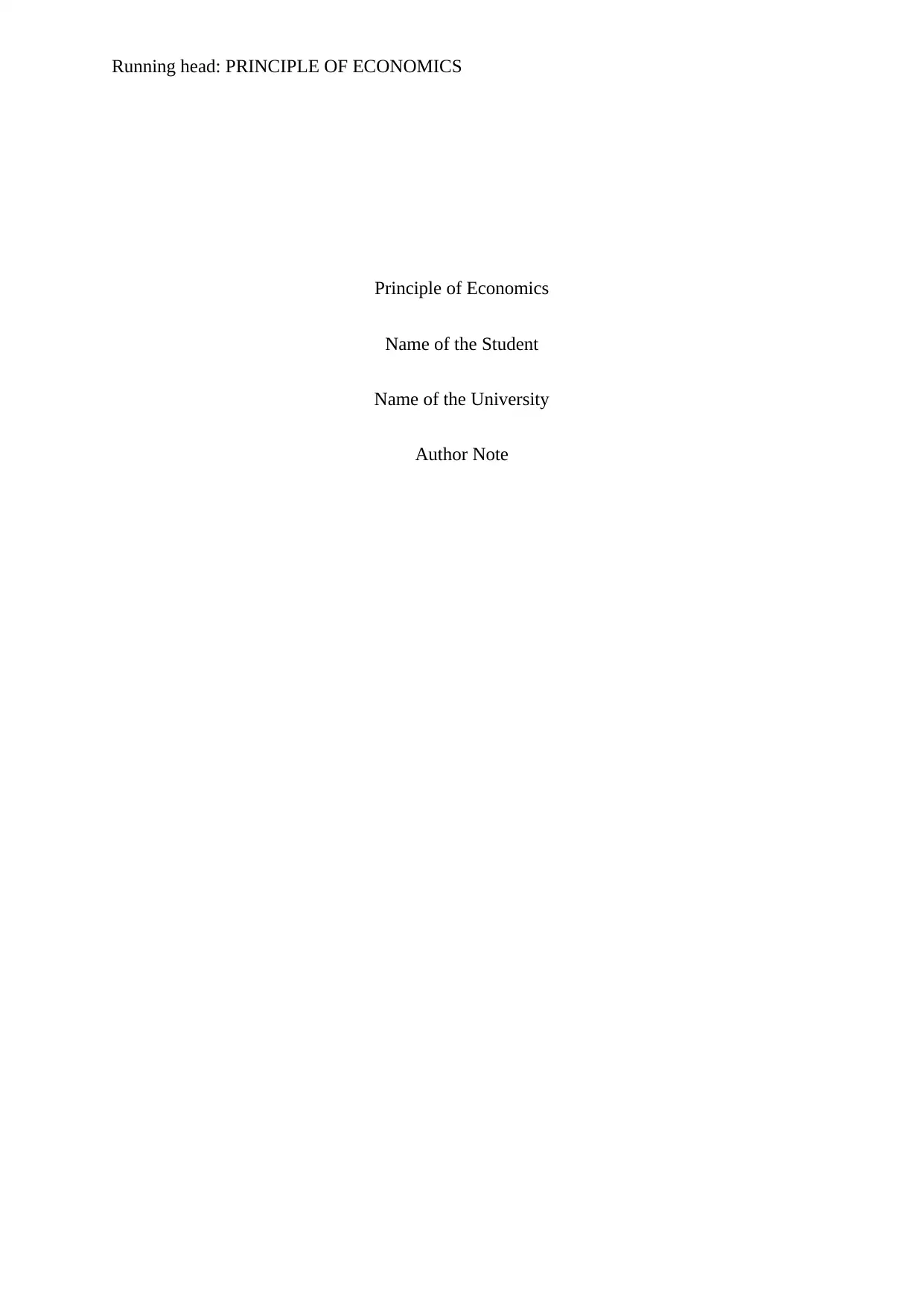
Running head: PRINCIPLE OF ECONOMICS
Principle of Economics
Name of the Student
Name of the University
Author Note
Principle of Economics
Name of the Student
Name of the University
Author Note
Paraphrase This Document
Need a fresh take? Get an instant paraphrase of this document with our AI Paraphraser
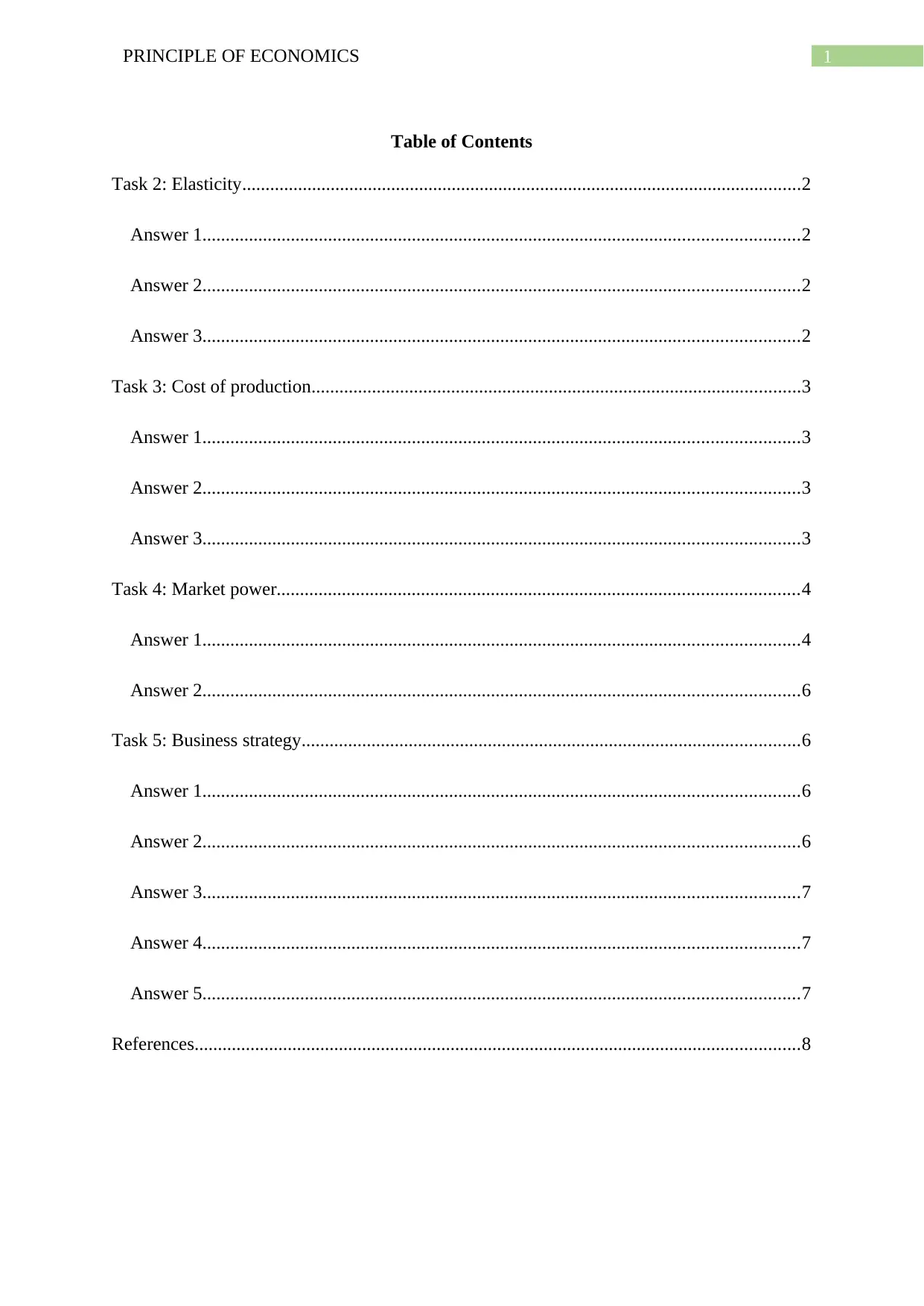
1PRINCIPLE OF ECONOMICS
Table of Contents
Task 2: Elasticity........................................................................................................................2
Answer 1................................................................................................................................2
Answer 2................................................................................................................................2
Answer 3................................................................................................................................2
Task 3: Cost of production.........................................................................................................3
Answer 1................................................................................................................................3
Answer 2................................................................................................................................3
Answer 3................................................................................................................................3
Task 4: Market power................................................................................................................4
Answer 1................................................................................................................................4
Answer 2................................................................................................................................6
Task 5: Business strategy...........................................................................................................6
Answer 1................................................................................................................................6
Answer 2................................................................................................................................6
Answer 3................................................................................................................................7
Answer 4................................................................................................................................7
Answer 5................................................................................................................................7
References..................................................................................................................................8
Table of Contents
Task 2: Elasticity........................................................................................................................2
Answer 1................................................................................................................................2
Answer 2................................................................................................................................2
Answer 3................................................................................................................................2
Task 3: Cost of production.........................................................................................................3
Answer 1................................................................................................................................3
Answer 2................................................................................................................................3
Answer 3................................................................................................................................3
Task 4: Market power................................................................................................................4
Answer 1................................................................................................................................4
Answer 2................................................................................................................................6
Task 5: Business strategy...........................................................................................................6
Answer 1................................................................................................................................6
Answer 2................................................................................................................................6
Answer 3................................................................................................................................7
Answer 4................................................................................................................................7
Answer 5................................................................................................................................7
References..................................................................................................................................8
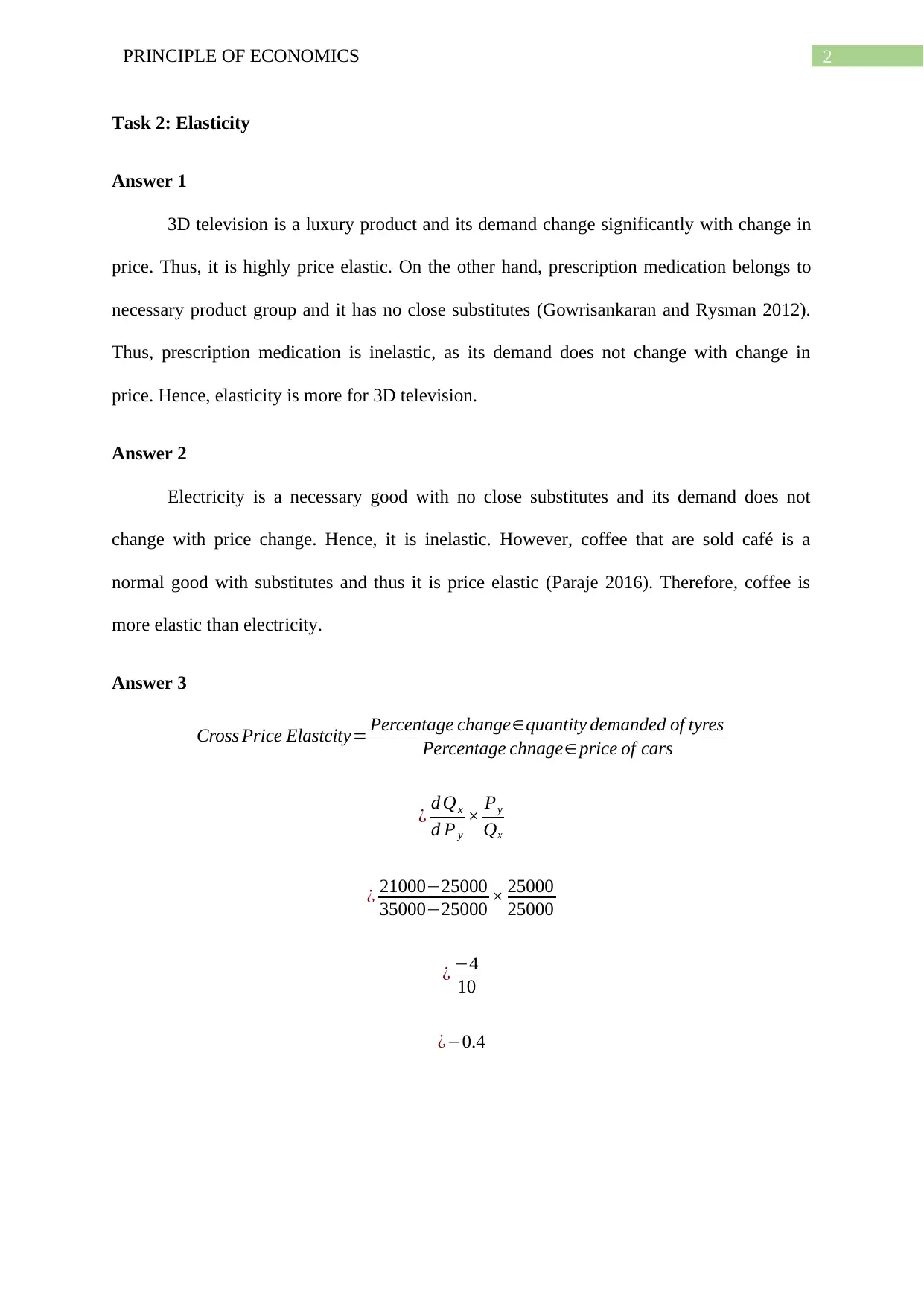
2PRINCIPLE OF ECONOMICS
Task 2: Elasticity
Answer 1
3D television is a luxury product and its demand change significantly with change in
price. Thus, it is highly price elastic. On the other hand, prescription medication belongs to
necessary product group and it has no close substitutes (Gowrisankaran and Rysman 2012).
Thus, prescription medication is inelastic, as its demand does not change with change in
price. Hence, elasticity is more for 3D television.
Answer 2
Electricity is a necessary good with no close substitutes and its demand does not
change with price change. Hence, it is inelastic. However, coffee that are sold café is a
normal good with substitutes and thus it is price elastic (Paraje 2016). Therefore, coffee is
more elastic than electricity.
Answer 3
Cross Price Elastcity= Percentage change∈quantity demanded of tyres
Percentage chnage∈price of cars
¿ d Qx
d P y
× Py
Qx
¿ 21000−25000
35000−25000 × 25000
25000
¿ −4
10
¿−0.4
Task 2: Elasticity
Answer 1
3D television is a luxury product and its demand change significantly with change in
price. Thus, it is highly price elastic. On the other hand, prescription medication belongs to
necessary product group and it has no close substitutes (Gowrisankaran and Rysman 2012).
Thus, prescription medication is inelastic, as its demand does not change with change in
price. Hence, elasticity is more for 3D television.
Answer 2
Electricity is a necessary good with no close substitutes and its demand does not
change with price change. Hence, it is inelastic. However, coffee that are sold café is a
normal good with substitutes and thus it is price elastic (Paraje 2016). Therefore, coffee is
more elastic than electricity.
Answer 3
Cross Price Elastcity= Percentage change∈quantity demanded of tyres
Percentage chnage∈price of cars
¿ d Qx
d P y
× Py
Qx
¿ 21000−25000
35000−25000 × 25000
25000
¿ −4
10
¿−0.4
⊘ This is a preview!⊘
Do you want full access?
Subscribe today to unlock all pages.

Trusted by 1+ million students worldwide
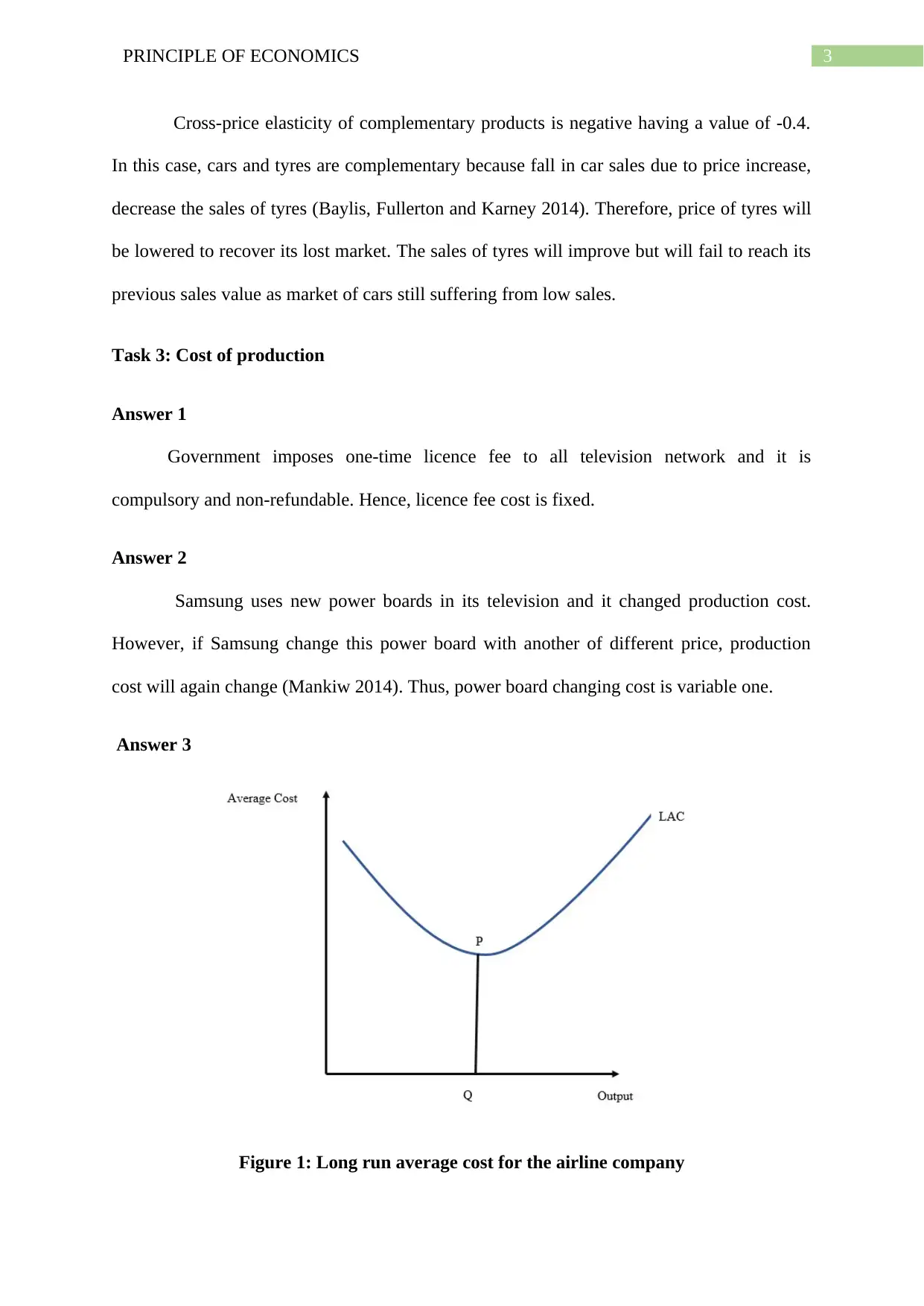
3PRINCIPLE OF ECONOMICS
Cross-price elasticity of complementary products is negative having a value of -0.4.
In this case, cars and tyres are complementary because fall in car sales due to price increase,
decrease the sales of tyres (Baylis, Fullerton and Karney 2014). Therefore, price of tyres will
be lowered to recover its lost market. The sales of tyres will improve but will fail to reach its
previous sales value as market of cars still suffering from low sales.
Task 3: Cost of production
Answer 1
Government imposes one-time licence fee to all television network and it is
compulsory and non-refundable. Hence, licence fee cost is fixed.
Answer 2
Samsung uses new power boards in its television and it changed production cost.
However, if Samsung change this power board with another of different price, production
cost will again change (Mankiw 2014). Thus, power board changing cost is variable one.
Answer 3
Figure 1: Long run average cost for the airline company
Cross-price elasticity of complementary products is negative having a value of -0.4.
In this case, cars and tyres are complementary because fall in car sales due to price increase,
decrease the sales of tyres (Baylis, Fullerton and Karney 2014). Therefore, price of tyres will
be lowered to recover its lost market. The sales of tyres will improve but will fail to reach its
previous sales value as market of cars still suffering from low sales.
Task 3: Cost of production
Answer 1
Government imposes one-time licence fee to all television network and it is
compulsory and non-refundable. Hence, licence fee cost is fixed.
Answer 2
Samsung uses new power boards in its television and it changed production cost.
However, if Samsung change this power board with another of different price, production
cost will again change (Mankiw 2014). Thus, power board changing cost is variable one.
Answer 3
Figure 1: Long run average cost for the airline company
Paraphrase This Document
Need a fresh take? Get an instant paraphrase of this document with our AI Paraphraser
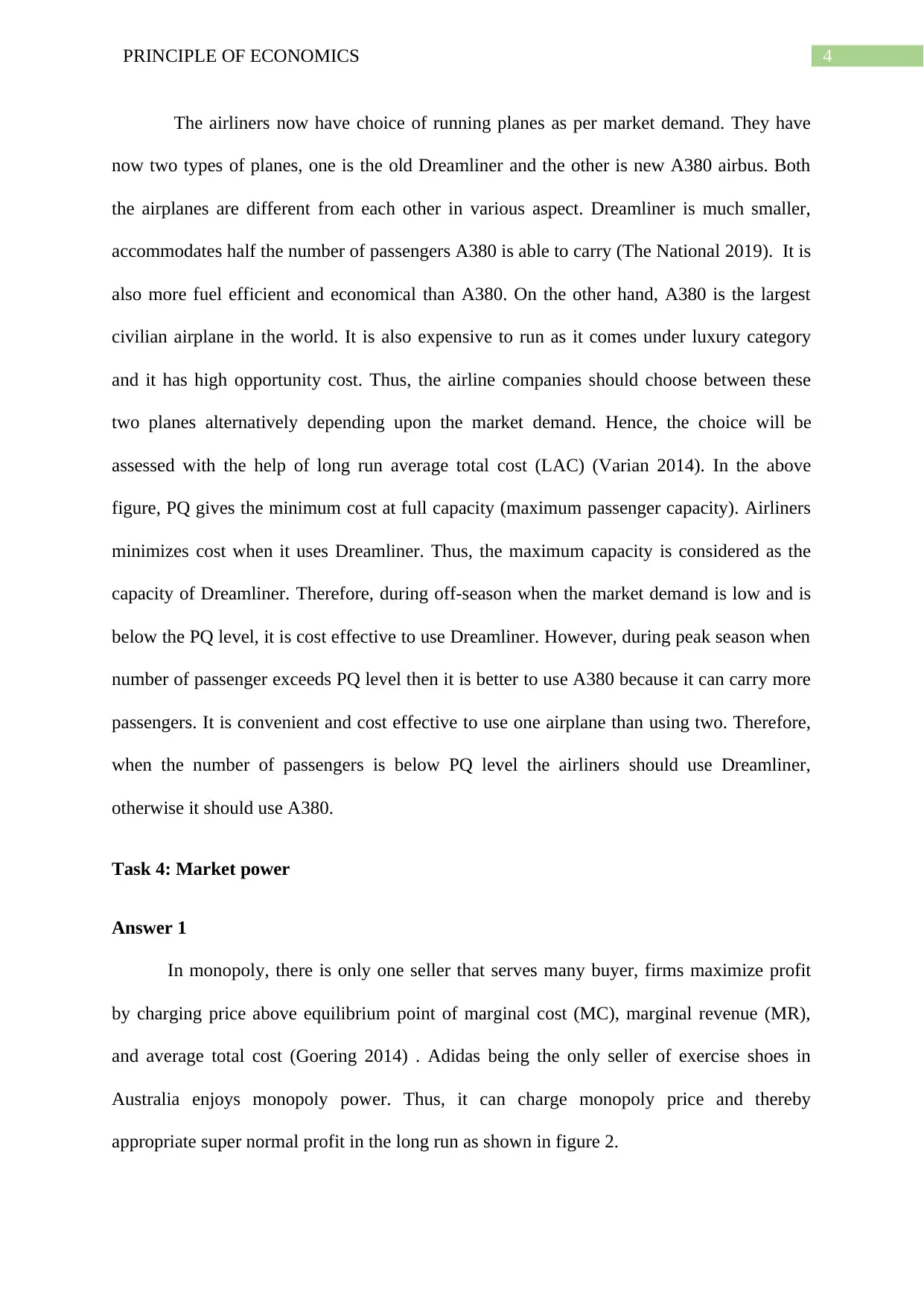
4PRINCIPLE OF ECONOMICS
The airliners now have choice of running planes as per market demand. They have
now two types of planes, one is the old Dreamliner and the other is new A380 airbus. Both
the airplanes are different from each other in various aspect. Dreamliner is much smaller,
accommodates half the number of passengers A380 is able to carry (The National 2019). It is
also more fuel efficient and economical than A380. On the other hand, A380 is the largest
civilian airplane in the world. It is also expensive to run as it comes under luxury category
and it has high opportunity cost. Thus, the airline companies should choose between these
two planes alternatively depending upon the market demand. Hence, the choice will be
assessed with the help of long run average total cost (LAC) (Varian 2014). In the above
figure, PQ gives the minimum cost at full capacity (maximum passenger capacity). Airliners
minimizes cost when it uses Dreamliner. Thus, the maximum capacity is considered as the
capacity of Dreamliner. Therefore, during off-season when the market demand is low and is
below the PQ level, it is cost effective to use Dreamliner. However, during peak season when
number of passenger exceeds PQ level then it is better to use A380 because it can carry more
passengers. It is convenient and cost effective to use one airplane than using two. Therefore,
when the number of passengers is below PQ level the airliners should use Dreamliner,
otherwise it should use A380.
Task 4: Market power
Answer 1
In monopoly, there is only one seller that serves many buyer, firms maximize profit
by charging price above equilibrium point of marginal cost (MC), marginal revenue (MR),
and average total cost (Goering 2014) . Adidas being the only seller of exercise shoes in
Australia enjoys monopoly power. Thus, it can charge monopoly price and thereby
appropriate super normal profit in the long run as shown in figure 2.
The airliners now have choice of running planes as per market demand. They have
now two types of planes, one is the old Dreamliner and the other is new A380 airbus. Both
the airplanes are different from each other in various aspect. Dreamliner is much smaller,
accommodates half the number of passengers A380 is able to carry (The National 2019). It is
also more fuel efficient and economical than A380. On the other hand, A380 is the largest
civilian airplane in the world. It is also expensive to run as it comes under luxury category
and it has high opportunity cost. Thus, the airline companies should choose between these
two planes alternatively depending upon the market demand. Hence, the choice will be
assessed with the help of long run average total cost (LAC) (Varian 2014). In the above
figure, PQ gives the minimum cost at full capacity (maximum passenger capacity). Airliners
minimizes cost when it uses Dreamliner. Thus, the maximum capacity is considered as the
capacity of Dreamliner. Therefore, during off-season when the market demand is low and is
below the PQ level, it is cost effective to use Dreamliner. However, during peak season when
number of passenger exceeds PQ level then it is better to use A380 because it can carry more
passengers. It is convenient and cost effective to use one airplane than using two. Therefore,
when the number of passengers is below PQ level the airliners should use Dreamliner,
otherwise it should use A380.
Task 4: Market power
Answer 1
In monopoly, there is only one seller that serves many buyer, firms maximize profit
by charging price above equilibrium point of marginal cost (MC), marginal revenue (MR),
and average total cost (Goering 2014) . Adidas being the only seller of exercise shoes in
Australia enjoys monopoly power. Thus, it can charge monopoly price and thereby
appropriate super normal profit in the long run as shown in figure 2.
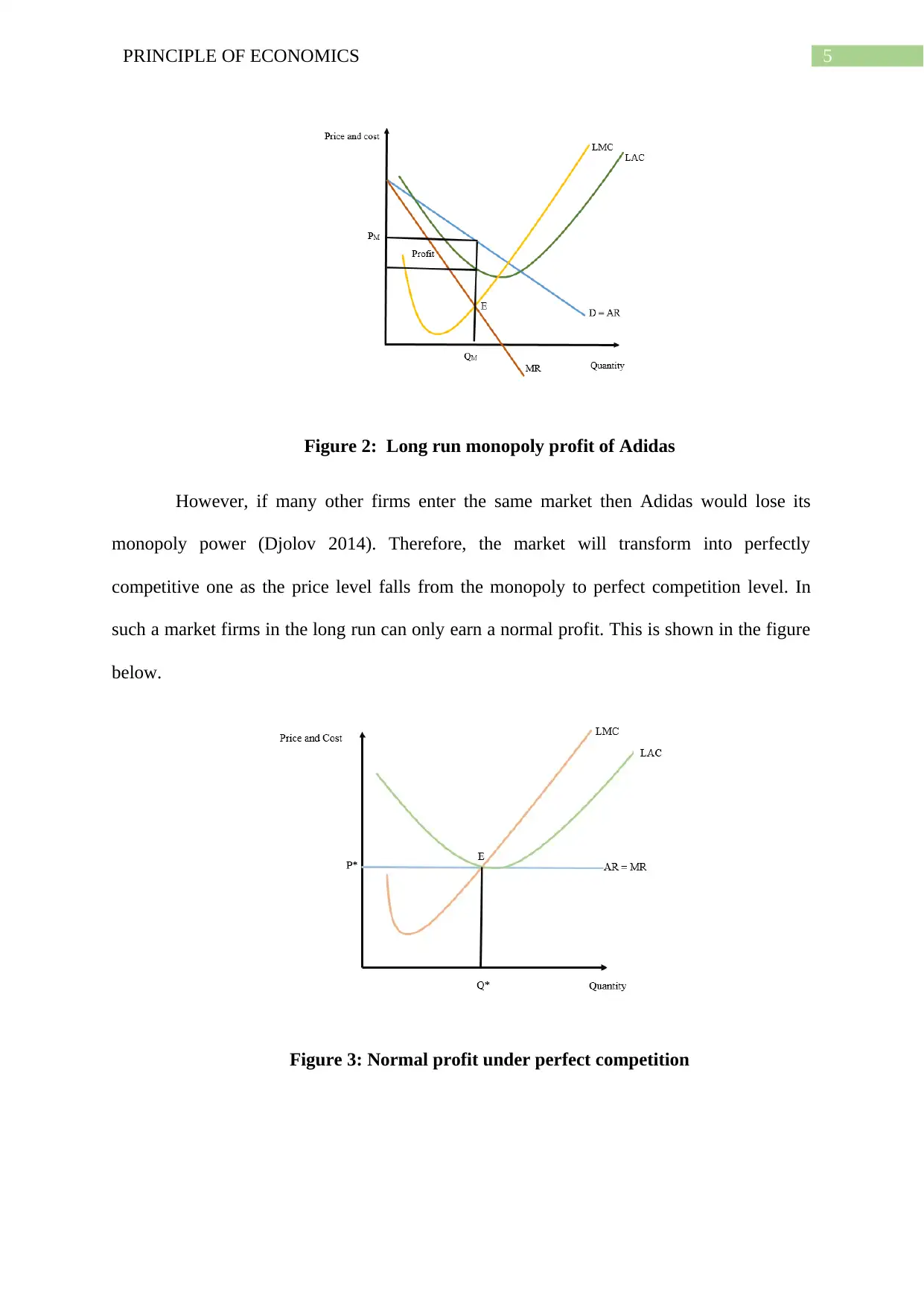
5PRINCIPLE OF ECONOMICS
Figure 2: Long run monopoly profit of Adidas
However, if many other firms enter the same market then Adidas would lose its
monopoly power (Djolov 2014). Therefore, the market will transform into perfectly
competitive one as the price level falls from the monopoly to perfect competition level. In
such a market firms in the long run can only earn a normal profit. This is shown in the figure
below.
Figure 3: Normal profit under perfect competition
Figure 2: Long run monopoly profit of Adidas
However, if many other firms enter the same market then Adidas would lose its
monopoly power (Djolov 2014). Therefore, the market will transform into perfectly
competitive one as the price level falls from the monopoly to perfect competition level. In
such a market firms in the long run can only earn a normal profit. This is shown in the figure
below.
Figure 3: Normal profit under perfect competition
⊘ This is a preview!⊘
Do you want full access?
Subscribe today to unlock all pages.

Trusted by 1+ million students worldwide
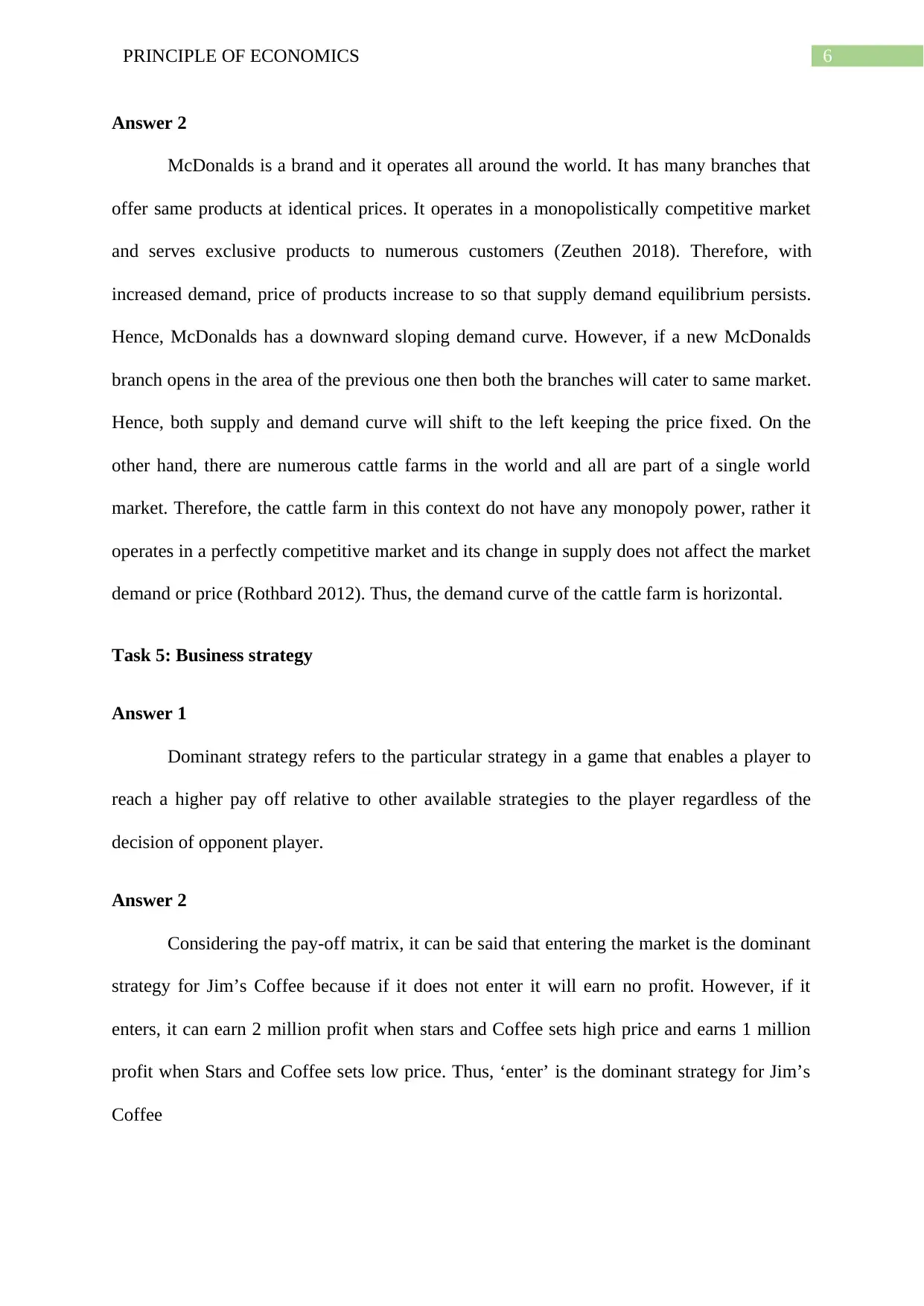
6PRINCIPLE OF ECONOMICS
Answer 2
McDonalds is a brand and it operates all around the world. It has many branches that
offer same products at identical prices. It operates in a monopolistically competitive market
and serves exclusive products to numerous customers (Zeuthen 2018). Therefore, with
increased demand, price of products increase to so that supply demand equilibrium persists.
Hence, McDonalds has a downward sloping demand curve. However, if a new McDonalds
branch opens in the area of the previous one then both the branches will cater to same market.
Hence, both supply and demand curve will shift to the left keeping the price fixed. On the
other hand, there are numerous cattle farms in the world and all are part of a single world
market. Therefore, the cattle farm in this context do not have any monopoly power, rather it
operates in a perfectly competitive market and its change in supply does not affect the market
demand or price (Rothbard 2012). Thus, the demand curve of the cattle farm is horizontal.
Task 5: Business strategy
Answer 1
Dominant strategy refers to the particular strategy in a game that enables a player to
reach a higher pay off relative to other available strategies to the player regardless of the
decision of opponent player.
Answer 2
Considering the pay-off matrix, it can be said that entering the market is the dominant
strategy for Jim’s Coffee because if it does not enter it will earn no profit. However, if it
enters, it can earn 2 million profit when stars and Coffee sets high price and earns 1 million
profit when Stars and Coffee sets low price. Thus, ‘enter’ is the dominant strategy for Jim’s
Coffee
Answer 2
McDonalds is a brand and it operates all around the world. It has many branches that
offer same products at identical prices. It operates in a monopolistically competitive market
and serves exclusive products to numerous customers (Zeuthen 2018). Therefore, with
increased demand, price of products increase to so that supply demand equilibrium persists.
Hence, McDonalds has a downward sloping demand curve. However, if a new McDonalds
branch opens in the area of the previous one then both the branches will cater to same market.
Hence, both supply and demand curve will shift to the left keeping the price fixed. On the
other hand, there are numerous cattle farms in the world and all are part of a single world
market. Therefore, the cattle farm in this context do not have any monopoly power, rather it
operates in a perfectly competitive market and its change in supply does not affect the market
demand or price (Rothbard 2012). Thus, the demand curve of the cattle farm is horizontal.
Task 5: Business strategy
Answer 1
Dominant strategy refers to the particular strategy in a game that enables a player to
reach a higher pay off relative to other available strategies to the player regardless of the
decision of opponent player.
Answer 2
Considering the pay-off matrix, it can be said that entering the market is the dominant
strategy for Jim’s Coffee because if it does not enter it will earn no profit. However, if it
enters, it can earn 2 million profit when stars and Coffee sets high price and earns 1 million
profit when Stars and Coffee sets low price. Thus, ‘enter’ is the dominant strategy for Jim’s
Coffee
Paraphrase This Document
Need a fresh take? Get an instant paraphrase of this document with our AI Paraphraser
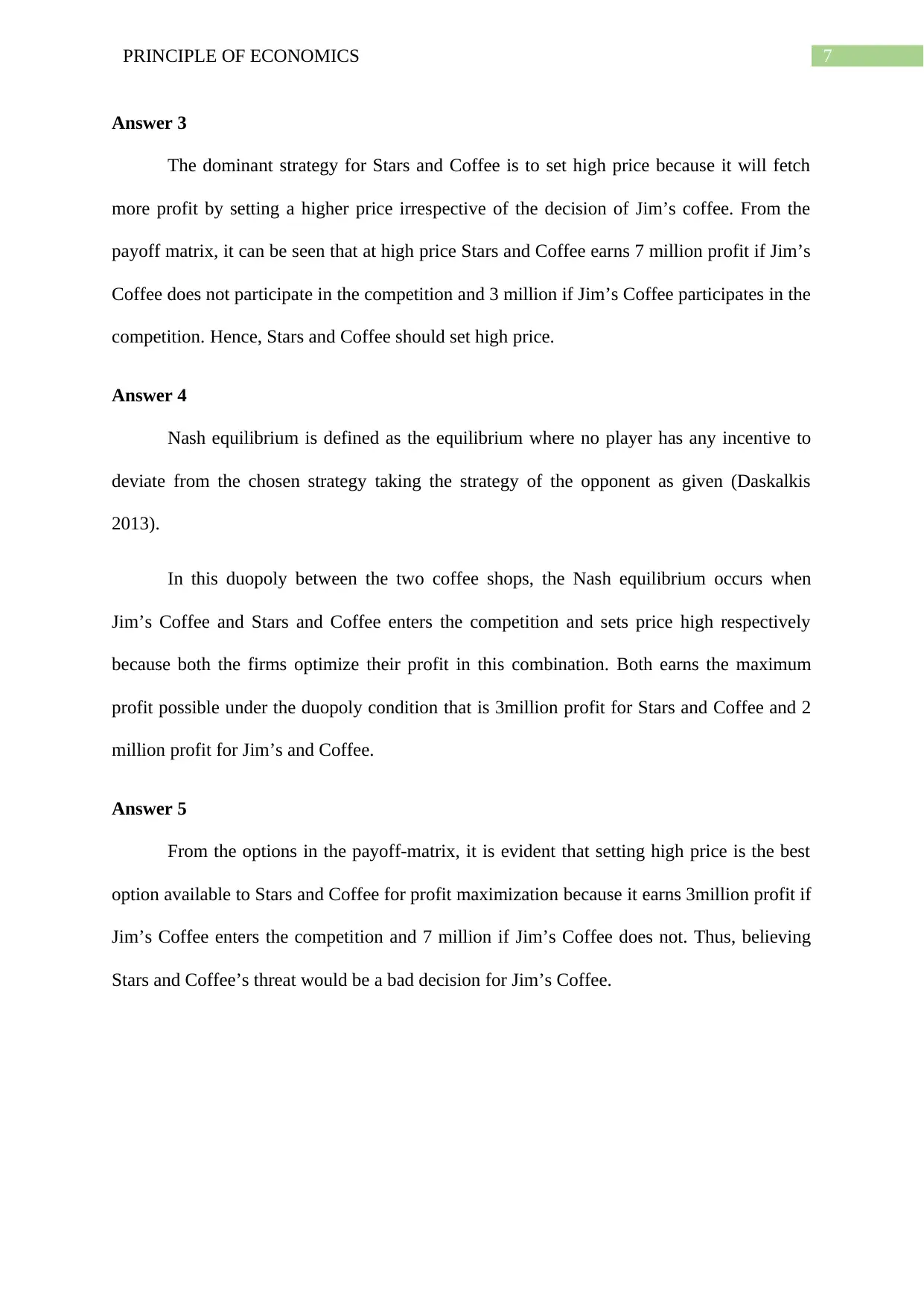
7PRINCIPLE OF ECONOMICS
Answer 3
The dominant strategy for Stars and Coffee is to set high price because it will fetch
more profit by setting a higher price irrespective of the decision of Jim’s coffee. From the
payoff matrix, it can be seen that at high price Stars and Coffee earns 7 million profit if Jim’s
Coffee does not participate in the competition and 3 million if Jim’s Coffee participates in the
competition. Hence, Stars and Coffee should set high price.
Answer 4
Nash equilibrium is defined as the equilibrium where no player has any incentive to
deviate from the chosen strategy taking the strategy of the opponent as given (Daskalkis
2013).
In this duopoly between the two coffee shops, the Nash equilibrium occurs when
Jim’s Coffee and Stars and Coffee enters the competition and sets price high respectively
because both the firms optimize their profit in this combination. Both earns the maximum
profit possible under the duopoly condition that is 3million profit for Stars and Coffee and 2
million profit for Jim’s and Coffee.
Answer 5
From the options in the payoff-matrix, it is evident that setting high price is the best
option available to Stars and Coffee for profit maximization because it earns 3million profit if
Jim’s Coffee enters the competition and 7 million if Jim’s Coffee does not. Thus, believing
Stars and Coffee’s threat would be a bad decision for Jim’s Coffee.
Answer 3
The dominant strategy for Stars and Coffee is to set high price because it will fetch
more profit by setting a higher price irrespective of the decision of Jim’s coffee. From the
payoff matrix, it can be seen that at high price Stars and Coffee earns 7 million profit if Jim’s
Coffee does not participate in the competition and 3 million if Jim’s Coffee participates in the
competition. Hence, Stars and Coffee should set high price.
Answer 4
Nash equilibrium is defined as the equilibrium where no player has any incentive to
deviate from the chosen strategy taking the strategy of the opponent as given (Daskalkis
2013).
In this duopoly between the two coffee shops, the Nash equilibrium occurs when
Jim’s Coffee and Stars and Coffee enters the competition and sets price high respectively
because both the firms optimize their profit in this combination. Both earns the maximum
profit possible under the duopoly condition that is 3million profit for Stars and Coffee and 2
million profit for Jim’s and Coffee.
Answer 5
From the options in the payoff-matrix, it is evident that setting high price is the best
option available to Stars and Coffee for profit maximization because it earns 3million profit if
Jim’s Coffee enters the competition and 7 million if Jim’s Coffee does not. Thus, believing
Stars and Coffee’s threat would be a bad decision for Jim’s Coffee.
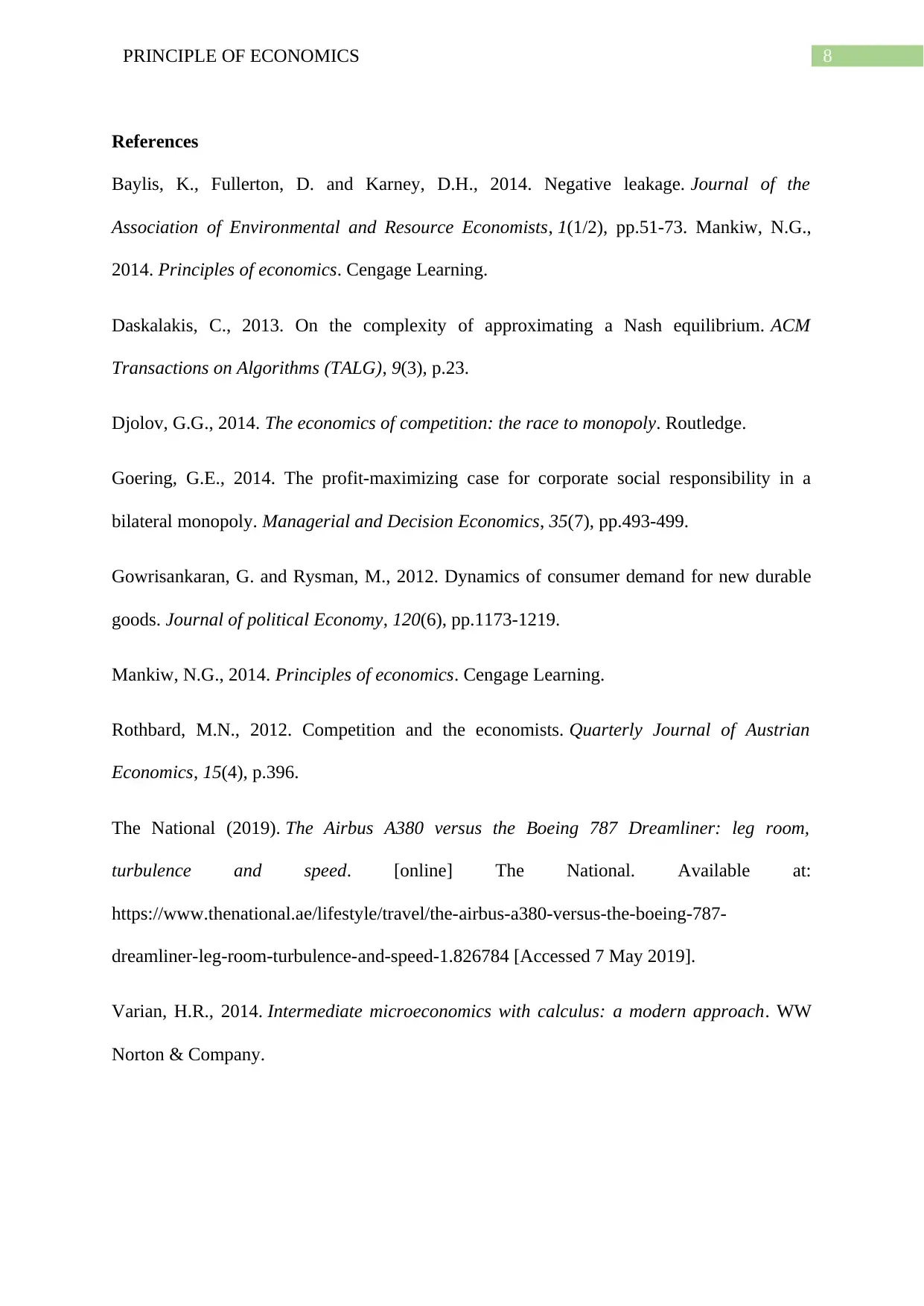
8PRINCIPLE OF ECONOMICS
References
Baylis, K., Fullerton, D. and Karney, D.H., 2014. Negative leakage. Journal of the
Association of Environmental and Resource Economists, 1(1/2), pp.51-73. Mankiw, N.G.,
2014. Principles of economics. Cengage Learning.
Daskalakis, C., 2013. On the complexity of approximating a Nash equilibrium. ACM
Transactions on Algorithms (TALG), 9(3), p.23.
Djolov, G.G., 2014. The economics of competition: the race to monopoly. Routledge.
Goering, G.E., 2014. The profit‐maximizing case for corporate social responsibility in a
bilateral monopoly. Managerial and Decision Economics, 35(7), pp.493-499.
Gowrisankaran, G. and Rysman, M., 2012. Dynamics of consumer demand for new durable
goods. Journal of political Economy, 120(6), pp.1173-1219.
Mankiw, N.G., 2014. Principles of economics. Cengage Learning.
Rothbard, M.N., 2012. Competition and the economists. Quarterly Journal of Austrian
Economics, 15(4), p.396.
The National (2019). The Airbus A380 versus the Boeing 787 Dreamliner: leg room,
turbulence and speed. [online] The National. Available at:
https://www.thenational.ae/lifestyle/travel/the-airbus-a380-versus-the-boeing-787-
dreamliner-leg-room-turbulence-and-speed-1.826784 [Accessed 7 May 2019].
Varian, H.R., 2014. Intermediate microeconomics with calculus: a modern approach. WW
Norton & Company.
References
Baylis, K., Fullerton, D. and Karney, D.H., 2014. Negative leakage. Journal of the
Association of Environmental and Resource Economists, 1(1/2), pp.51-73. Mankiw, N.G.,
2014. Principles of economics. Cengage Learning.
Daskalakis, C., 2013. On the complexity of approximating a Nash equilibrium. ACM
Transactions on Algorithms (TALG), 9(3), p.23.
Djolov, G.G., 2014. The economics of competition: the race to monopoly. Routledge.
Goering, G.E., 2014. The profit‐maximizing case for corporate social responsibility in a
bilateral monopoly. Managerial and Decision Economics, 35(7), pp.493-499.
Gowrisankaran, G. and Rysman, M., 2012. Dynamics of consumer demand for new durable
goods. Journal of political Economy, 120(6), pp.1173-1219.
Mankiw, N.G., 2014. Principles of economics. Cengage Learning.
Rothbard, M.N., 2012. Competition and the economists. Quarterly Journal of Austrian
Economics, 15(4), p.396.
The National (2019). The Airbus A380 versus the Boeing 787 Dreamliner: leg room,
turbulence and speed. [online] The National. Available at:
https://www.thenational.ae/lifestyle/travel/the-airbus-a380-versus-the-boeing-787-
dreamliner-leg-room-turbulence-and-speed-1.826784 [Accessed 7 May 2019].
Varian, H.R., 2014. Intermediate microeconomics with calculus: a modern approach. WW
Norton & Company.
⊘ This is a preview!⊘
Do you want full access?
Subscribe today to unlock all pages.

Trusted by 1+ million students worldwide
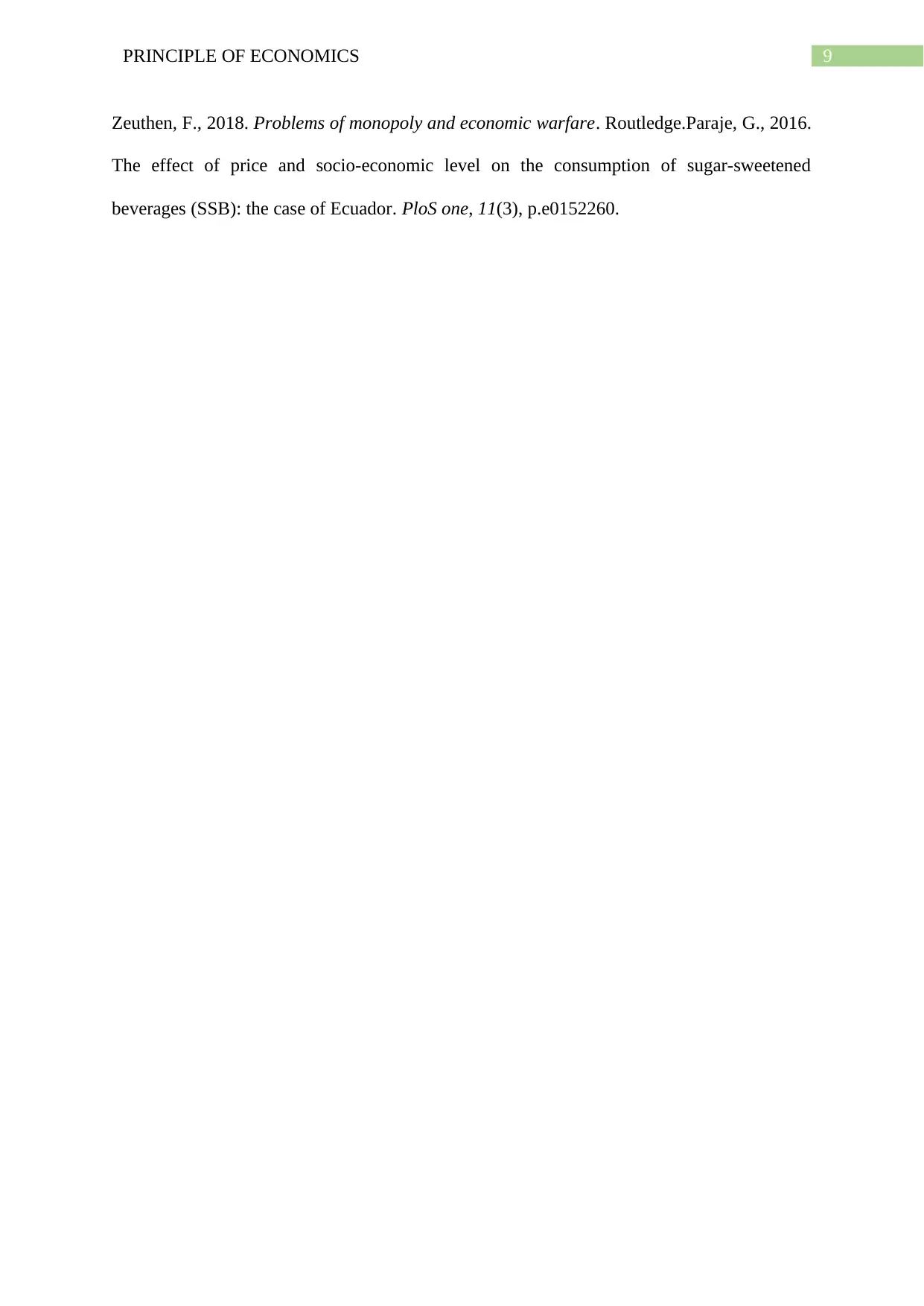
9PRINCIPLE OF ECONOMICS
Zeuthen, F., 2018. Problems of monopoly and economic warfare. Routledge.Paraje, G., 2016.
The effect of price and socio-economic level on the consumption of sugar-sweetened
beverages (SSB): the case of Ecuador. PloS one, 11(3), p.e0152260.
Zeuthen, F., 2018. Problems of monopoly and economic warfare. Routledge.Paraje, G., 2016.
The effect of price and socio-economic level on the consumption of sugar-sweetened
beverages (SSB): the case of Ecuador. PloS one, 11(3), p.e0152260.
1 out of 10
Related Documents
Your All-in-One AI-Powered Toolkit for Academic Success.
+13062052269
info@desklib.com
Available 24*7 on WhatsApp / Email
![[object Object]](/_next/static/media/star-bottom.7253800d.svg)
Unlock your academic potential
Copyright © 2020–2025 A2Z Services. All Rights Reserved. Developed and managed by ZUCOL.





